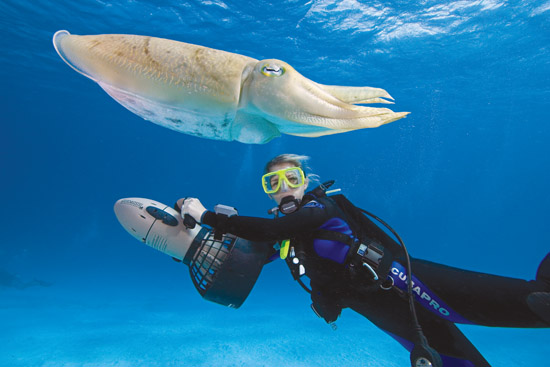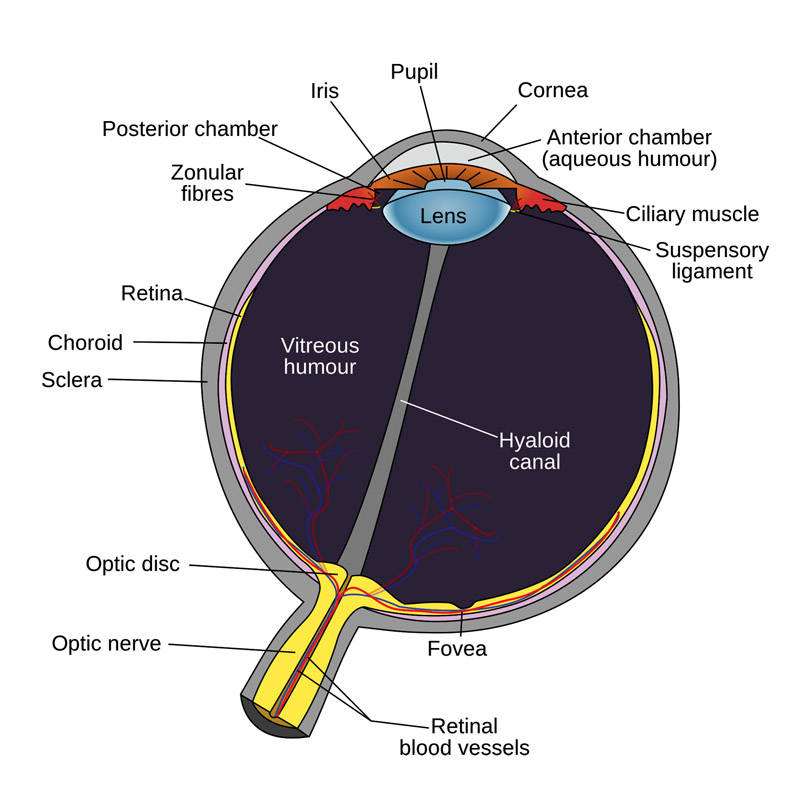Seeing Underwater
Visibility notwithstanding, dive masks are the solution… for human beings
By Dr. David Sawatzky
The eye is really just a complex, living camera. The main parts of the eye are the cornea, iris, lens and retina. The cornea is clear and has no blood supply. It protects the eye but its main function is to focus the light that enters the eye on the retina. A diopter is a measure of the power of a lens and the power of the cornea is equivalent to a +43 diopter lens. It is composed of five layers but for simplicity can be thought of as having a thin layer on the surface (epithelium) and a body composed of flat stromal cells. The epithelium has many nerve endings; therefore, when a hair or some other foreign body gets in the eye and scratches the cornea, it hurts a great deal.
After passing through the cornea, light crosses the anterior chamber and then goes through the opening in the iris called the pupil. The iris is a muscle and forms the coloured part of the eye; when we say someone has blue eyes or brown eyes, we are really saying that their iris is blue or brown. The iris functions the same as the aperture in a camera; it leaves a large opening when the light is dim and a small opening when the light is bright. This controls the amount of light that enters the posterior part of the eye.
When we are excited or frightened the pupil dilates, allowing more light into the eye, allowing us to see more clearly. Men are said to consider women more attractive if they have larger pupils (they assume the woman is excited to see them). Women in ancient Egypt used to rub juice from the belladonna plant (which contains the drug atropine) in their eyes to dilate the pupils to make themselves appear more beautiful.
Light has to be refracted (bent) just the right amount so that it is focused on the retina for us to see clearly. Light from objects that are far away has to be refracted less than light from near objects. The purpose of the lens is to change the refractive power of the eye to accommodate for objects at different distances. As the ciliary muscles contract, they release tension on the suspensory ligament of the lens and the natural elasticity of the lens capsule causes it to assume a more rounded shape. In a normal eye, light from distant objects is focused on the retina when the ciliary muscles are relaxed. To focus the light from near objects, the ciliary muscles contract and the lens becomes rounder, increasing the focusing power of the eye.
When light hits the retina, a series of chemical changes occur. These generate an electrical signal that is transmitted to the brain and through a very complex process this signal is translated into the images we see. Now that we have a basic understanding of how the eye works, what happens when we try and see underwater?

Seeing Underwater
The amount light is refracted when it passes through the cornea is due to the difference in density between air and the cornea. The cornea has a density almost the same as water and therefore the difference in density between water and the cornea is very small. When light passes from water to the cornea, very little refraction occurs and the image will not be in focus until it is behind the retina. This is why when we open our eyes underwater everything appears blurry!
The solution is to wear a dive mask. The dive mask creates airspace in front of the cornea, allowing the normal amount of refraction to occur when light passes from the air to the cornea, giving us the same vision as on the surface.
Now that we can see clearly, we notice that everything appears larger underwater than it does on land. What’s going on? Glass has almost the same optical properties as water and very little refraction occurs as light passes from water into the mask lens. However, the density of the mask lens is much greater than the density of the air inside the mask. As light passes from the mask lens into the air it diverges (the opposite of focusing). This results in objects appearing larger than they would out of the water. The magnification is about 25 percent so that a 16-inch (40cm) long fish will appear to be 20 inches (50cm) in length. Exactly the same mechanism occurs when we look into very clear water from above the surface (light coming from the fish diverges as it passes from water into air). Fish we see in water appear 25 percent larger than they really are.
We have several mechanisms for helping us determine how far away an object is. One is the apparent size of the object. We know how large our dive buddy is on the surface at various distances (they appear smaller when they are farther away). When we look at our buddy underwater, we notice their size and use our experience on land to estimate how far away they are. Underwater they appear 25 percent larger than they do in air and thus we think they are 25 percent closer than they actually are. If we reach out to touch them (or anything else) we may find that our arm is too short! The bottom line is that underwater things appear to be 25 percent larger and 25 percent closer than they really are. This means that divers have a valid reason for over estimating the size of the fish they saw!
Colour
Underwater colours often seem drab. This is because water absorbs light. Colours are simply light of different wavelengths. Water absorbs them at different rates so that after light has passed through about 16 feet (5m) of water, most of the reds are absorbed. After 33 feet (10m) the oranges are also absorbed. The yellows disappear next, followed by the greens and blues. By the time we are deeper than 66 feet (20m), everything appears blue/grey. Using artificial lights restores the colours but light from a flashlight does not have exactly the same wavelengths as light from the sun, so the colours we see will not be quite the same as if the object was out of the water.
Turbidity
The ability of light to pass through water (and our ability to see clearly) is influenced by its turbidity. ‘Things suspended in the water’ and ‘things dissolved in the water’ determine the degree of turbidity. Suspended things include silt, plankton, etc. while dissolved things include salt and chemicals. When a diver is swimming near the bottom, water movement caused by their fins often stirs up the silt and for a while the water behind them has high turbidity. When open water divers enter caves the water is clear in front of them and often they do not realize until they turn around that they have been kicking up the silt and they can no longer see the way out of the cave.
If water is still, silt will eventually sink to the bottom and visibility will improve. The time this process takes depends upon the size of the silt particles. Grains of sand will settle in a minute or two while the ultra-fine grains of rock flour produced by a glacier will take several weeks to completely settle out. During a cave diving trip under the Columbia Ice Fields in 1987 the water was ‘air clear’ when we arrived at the dive site. After we had made the area safe and several hundred (or thousand) kilograms (pounds) of mud and rocks had been dropped into the water, the visibility was less than one inch (2.5cm)! We went back to the surface and returned to the dive site two days later. The silt was so fine (glacial flour) that even though the water was absolutely still, visibility had only improved to 12 inches (30cm); it would have taken several weeks for the silt to completely settle out.
Salt water has large quantities of salt and other chemicals dissolved in it and, for this reason, can never be as clear as fresh water. The best clarity to be found in the ocean is around 200 feet (60m), whereas in some fresh water caves visibility is over 1,000 feet (300m). These ideal conditions are rarely encountered and visibility is usually less. For example, the Ottawa River contains water with many dissolved chemicals (from soil, trees, etc.) and visibility is seldom more than 20 feet (6m). The St. Lawrence River used to be similar but the infestation of billions of zebra mussels has changed this situation drastically. Zebra mussels are filter feeders and each mussel filters the silt and some chemicals out of a large amount of water every day. The result is that places where 20-foot (6m) visibility used to be considered good, now visiblity of 100 feet (30m) or more is not uncommon. The problem is, divers can now see the wrecks clearly but they are covered in many layers of zebra mussels!
Leave a Comment








